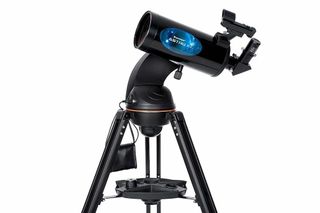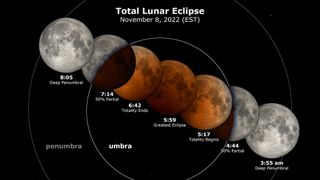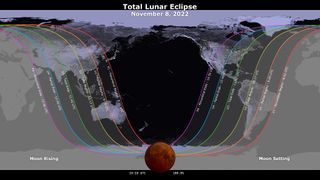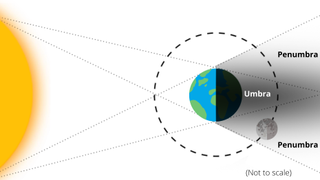Beaver Blood Moon lunar eclipse 2022: Everything you need to know
A reddish moon will be visible on Nov. 8 for 85 minutes from North America, parts of South America, Asia, Australia and New Zealand.
Update for 9:20 am ET, Nov. 8: The Beaver Blood Moon lunar eclipse of Nov. 8 has ended and trilled skywatchers around the world. Read our wrap story for photos and videos.
The second total lunar eclipse of 2022 will turn the moon a reddish-copper color for 85 minutes on Nov. 8, 2022, though what you'll see during this safe naked-eye event will depend on your location on the planet.
Often colloquially called a Blood Moon, a total lunar eclipse, happens as the full moon (in this case November's full Beaver Moon) moves into the deep umbral shadow of the Earth and receives only light first filtered by Earth's atmosphere, will be visible from North America and parts of South America, Asia, Australia and New Zealand.
A partial lunar eclipse will be visible from Iceland, parts of South America, south and central Asia and Russia. A penumbral lunar eclipse — when the moon is in the lighter penumbral shadow from our planet — will be visible from eastern Brazil and Argentina, northern Scandinavia and the Middle East.
You can watch the total lunar eclipse on Space.com for free, courtesy of several webcasts from observatories across the United States beginning at about 3 a.m. EST (0800 GMT).
Related: Lunar eclipses 2022: When, where & how to see them

Jamie Carter is an experienced science, technology and travel journalist. He is the editor of WhenIsTheNextEclipse.com and author of A Stargazing Program For Beginners.

Looking for a telescope for the lunar eclipse? We recommend the Celestron Astro Fi 102 as the top pick in our best beginner's telescope guide.
This is a global event happening at the same time for all observers, but local time will depend on your location, which you can find out on TimeandDate.com.
According to NASA, the partial lunar eclipse begins November 8 at 4:44 a.m. EST (0844 GMT). Lunar totality — the Blood Moon phase — begins on November 8 at 05:17 a.m EST (0917 GMT) and ends at 6:42 a.m. EST (1042 GMT). A partial eclipse will then be visible until 8:05 a.m. EST (1205 GMT). Note that the faint penumbral moon phase of the eclipse will begin about an hour before the first partial eclipse and end about an hour after the second partial eclipse.
Throughout the entire event, it will also be possible to see the seventh planet Uranus close to the eclipsed moon. In parts of Asia — including Hong Kong — Uranus will be briefly hidden behind the moon during totality.

If you want to photograph the moon or want to prepare your gear for the total lunar eclipse, check out our best cameras for astrophotography and best lenses for astrophotography. Read our guides on how to photograph a lunar eclipse, as well as how to photograph the moon with a camera for some helpful tips to plan out your lunar photo session.
This will be the second and final lunar eclipse in 2022. The last one took place on May 16, 2022. There will also be two lunar eclipses in 2023, though they won't be nearly as impressive a spectacle. The first on May 5 to 6, 2023 is a faint penumbral lunar eclipse visible from southern and eastern Europe, Antarctica, most of Asia, Australia, Africa as well as the Pacific, Indian and Atlantic oceans.
The second will be a slight partial lunar eclipse on Oct. 28 to 29, 2023 visible at least partly from Europe, Asia, Australia, Africa, North America, northern and eastern South America, the Arctic, Antarctica and the Pacific, Atlantic and Indian oceans.
Here are some tips to help you get the most out of the November 8 total lunar eclipse.
What time is the blood moon?
What you'll see during the total lunar eclipse entirely depends on where you observe it from. A schedule specific to your location is available on TimeandDate.com. Here's when to see the phases of the total lunar eclipse from North America (all times are for November 8, 2022):
| Eclipse event | EST | CST | MST | PST |
|---|---|---|---|---|
| Penumbra first visible? | 3:48 a.m. | 2:48 a.m. | 1:48 a.m. | 12:48 a.m. |
| Moon enters umbra | 4:08 a.m. | 3:08 a.m. | 2:08 a.m. | 1:08 a.m. |
| Total eclipse begins | 5:16 a.m. | 4:16 a.m. | 3:16 a.m. | 2:16 a.m. |
| Mid-eclipse | 5:59 a.m. | 4:59 a.m. | 3:59 a.m. | 2:59 a.m. |
| Total eclipse ends | 6:41 a.m. | 5:41 a.m. | 4:41 a.m. | 2:41 a.m. |
| Moon leaves umbra | ---- | ---- | 5:49 a.m. | 4:49 a.m. |
| Penumbra last visible? | ---- | ---- | 6:09 a.m. | 5:09 a.m. |
It's worth getting outside at least an hour before totality to watch the partial lunar eclipse. As the moon begins to enter Earth's dark central (umbral) shadow it turns dark and, gradually, grows reddish.
Where to watch the lunar eclipse online
There are several livestreams of the event scheduled for YouTube, embedded below.
First up is Lowell Observatory in Flagstaff, Arizona, which will begin livestreaming views through telescopes at 2:00 a.m. MST on November 8 (4:00 a.m. EST and 0800 GMT on November 8) on the Lowell Observatory YouTube channel. Lowell Historian Kevin Schindler and Moon expert John Compton will host, with totality at 4:00 a.m. MST (6:00 a.m. EST and 1000 GMT).
There is also a broadcast scheduled by TimeandDate.com which is available on their website and YouTube channel. It plans to broadcast the entire event from its mobile observatory in Roswell, New Mexico and take live feeds from San Diego, California and from Perth in Western Australia. The broadcast is scheduled to start at 4:00 a.m. EST (0800 GMT).
Astronomical science and education service the Virtual Telescope Project will livestream views of the event from around the world on its WebTV page. The online, free lunar total eclipse session is scheduled for 4:30 a.m. EST (0830 GMT) and will include astro-imagers from the U.S., Canada, Australia and India. It's presented by astrophysicist Gianluca Masi at the Virtual Telescope Project.
There will likely be more webcasts as we get closer to the November 8 event. We'll share those on Space.com in a dedicated webcast guide as we learn more.
Why is a blood moon red?
Despite its nickname, a totally eclipsed moon looks an orangey-copper reddish color and not a blood-red color.
During a total lunar eclipse, a full moon passes first into the penumbra or fuzzy outer shadow of Earth (remaining gray, but getting darker) and then enters Earth's umbra or deep central shadow. The only sunlight reaching the moon passes through Earth's atmosphere, which turns the lunar surface red because of Rayleigh scattering. Red, orange and yellow light have the longest wavelengths, so these light waves strike few particles as they travel through Earth's atmosphere compared to blue light, which has shorter wavelengths. The more dust or clouds in Earth's atmosphere during the eclipse, the redder the Moon will appear, according to NASA.
It's rather as if thousands of sunsets and sunrises are being reflected by the moon.
Penumbral eclipses are much more subtle. They occur when a full moon passes only through the much lighter penumbra shadow of Earth. The moon's darkening is obvious compared to the glare of a full moon, but it's not a particularly dramatic change. The moon does not turn red during a penumbral lunar eclipse.
Where is the lunar eclipse visible?

This total lunar eclipse will be visible in North America and parts of South America, Asia, Australia and New Zealand, but as you can see from the visibility diagrams, what you see — and when you see it — entirely depends on where you are located.
Only the partial phases will be visible from Iceland, parts of South America, south and central Asia and Russia, while just the penumbral phases will be visible from eastern Brazil and Argentina, northern Scandinavia and the Middle East. Europe and Africa are on the day-side of the planet during this eclipse and will not observe anything.
Lunar eclipse viewing tips
Unlike a solar eclipse, which requires certified eclipse glasses, an eclipse of the moon is completely safe to look at with your naked eyes. Also unlike a solar eclipse, the totality phase lasts much more than just a few minutes.
Related: How to observe the sun safely (and what to look for)
The lunar eclipse on November 8, 2022, will take several hours, with the partial eclipse lasting about an hour on either side of an 85 minutes-long 'Blood Moon' totality.
The penumbral phases are interesting, but we recommend you're outside to see the start of the partial phase. As well as it being an interesting event in itself that will also help get your eyes adjusted to the darkness ahead of totality.
Equipment such as cameras, telescopes and binoculars may need a few hours to adjust to the different temperatures and humidity outside, so bring them out as soon as possible to avoid issues with dew.
Astrophotographers will want to consult our guide on how to photograph a lunar eclipse. Make sure to practice before the big event to make sure all your settings are correct and that you are comfortable with the process.
When you're outside, make sure you dress for the weather and do what you can to feel comfortable for the event. Lawn chairs, hydration and keeping bright phones or flashlights away will maximize the pleasure of the eclipse.
What causes lunar eclipses?

Lunar eclipses occur when a full moon passes into the shadow of the Earth. Since the Earth and the moon have slightly tilted orbits to each other, this happens generally a couple of times a year when the tilts of the orbits align during a full moon. Depending on how that happens, you may get a penumbral, partial or total eclipse.
Partial eclipses occur when the moon goes partially into the umbra, or deeper shadow, of our planet. The moon will also not turn red, but you will see a dark "bite" out of the visible surface, which represents the Earth's shadow.
Penumbral eclipses happen when the moon skirts into the lighter shadow of the Earth. This type of eclipse is sometimes hard to see, as the moon will only grow slightly darker. It also will not turn red.
During a total lunar eclipse, all three types of lunar eclipse are seen as phases as the full moon travels through the center of Earth's shadow in space.
When is the next lunar eclipse?
In 2023 there are two lunar eclipses to look forward to. On May 5 to 6 of that year a penumbral lunar eclipse will be visible, at least partially, from southern and eastern Europe, Antarctica, most of Asia, Australia, Africa as well as the Pacific, Indian and Atlantic oceans.
The second and final lunar eclipse of 2023, a partial, will occur on Oct. 28 to 29. This eclipse will be visible at least partially from Europe, Asia, Australia, Africa, North America, northern and eastern South America, the Arctic, Antarctica and the Pacific, Atlantic and Indian oceans.
Following a penumbral lunar eclipse on March 25, 2024, and a partial lunar eclipse on September 18, 2024, the next total lunar eclipse will occur on March 14, 2025. The total phase will be visible from North America, South America and the Pacific, with some of the phases visible from Europe, Africa and Asia.
Editor's Note: If you snap an amazing lunar eclipse photo and would like to share it with Space.com's readers, send your photo(s), comments, and your name and location to spacephotos@space.com
Jamie Carter is the editor of WhenIsTheNextEclipse.com
Join our Space Forums to keep talking about space on the latest missions, night sky and more! And if you have a news tip, correction or comment, let us know at: community@space.com.
Bibliography
Hong Kong Space Museum Lunar Eclipse. Hong Kong Space Museum. Retrieved October 28, 2022, from https://www.lcsd.gov.hk/CE/Museum/Space/en_US/web/spm/resources/special-astronomical-events/lunar-eclipse/total-lunar-eclipse.html
Hunt, J. L. (2022, October 9). 2022, November 8: Morning lunar eclipse, Mercury, superior conjunction. When the Curves Line Up. Retrieved October 28, 2022, from https://whenthecurveslineup.com/2022/10/09/2022-november-8-morning-lunar-eclipse-mercury-superior-conjunction/
Lowell Observatory/YouTube. (2022, October 11). Total Lunar Eclipse | November 8, 2022. YouTube. Retrieved October 28, 2022, from https://www.youtube.com/watch?v=DsXS3iDs0yA&ab_channel=LowellObservatory
NASA Science Visualization Studio: November 8, 2022 Total Lunar Eclipse: Shadow view. NASA. Retrieved October 28, 2022, from https://svs.gsfc.nasa.gov/5032
TimeandDate. Eclipse map. Map of total lunar eclipse on November 8, 2022. Retrieved October 28, 2022, from https://www.timeanddate.com/eclipse/map/2022-november-8
TimeandDate. Live stream: Total lunar eclipse November 8, 2022. LIVE Stream: Total Lunar Eclipse November 2022. Retrieved October 28, 2022, from https://www.timeanddate.com/live/eclipse-lunar-2022-november-8
TimeandDate. November 7–8, 2022 total Lunar Eclipse (blood moon). Total Lunar Eclipse on November 7–8, 2022 – Where and When to See. Retrieved October 28, 2022, from https://www.timeanddate.com/eclipse/lunar/2022-november-8
TimeandDate/YouTube. Live: Total lunar eclipse - november 08, 2022. YouTube. Retrieved October 28, 2022, from https://www.youtube.com/watch?v=BjKUlaGmE2g&ab_channel=timeanddate
The Virtual Telescope Project 2.0. Virtual Telescope's webtv. The Virtual Telescope Project WebTV. Retrieved October 28, 2022, from https://www.virtualtelescope.eu/webtv/
Wasser, M., Wright, E., & Vogel, T. (2022, October 13). What you need to know about the lunar eclipse. NASA Science. Retrieved October 28, 2022, from https://moon.nasa.gov/news/185/what-you-need-to-know-about-the-lunar-eclipse
Join our Space Forums to keep talking space on the latest missions, night sky and more! And if you have a news tip, correction or comment, let us know at: community@space.com.
Get the Space.com Newsletter
Breaking space news, the latest updates on rocket launches, skywatching events and more!

Jamie is an experienced science, technology and travel journalist and stargazer who writes about exploring the night sky, solar and lunar eclipses, moon-gazing, astro-travel, astronomy and space exploration. He is the editor of WhenIsTheNextEclipse.com and author of A Stargazing Program For Beginners, and is a senior contributor at Forbes. His special skill is turning tech-babble into plain English.